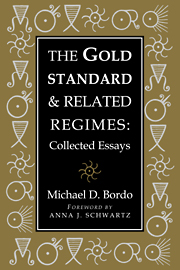Book contents
- Frontmatter
- Contents
- Foreword
- 1 The Gold Standard and Related Regimes: Introduction to the Collection
- Part I History of Doctrine and the Gold Standard
- Part II The Gold Standard as a Commodity Standard
- 5 The Classical Gold Standard: Some Lessons for Today
- 6 A Model of the Classical Gold Standard with Depletion
- Part III The Gold Standard as a Contingent Rule
- Part IV Historical Case Studies
- Part V The Bretton Woods International Monetary System
- Index
- Titles in the series
5 - The Classical Gold Standard: Some Lessons for Today
Published online by Cambridge University Press: 19 October 2009
- Frontmatter
- Contents
- Foreword
- 1 The Gold Standard and Related Regimes: Introduction to the Collection
- Part I History of Doctrine and the Gold Standard
- Part II The Gold Standard as a Commodity Standard
- 5 The Classical Gold Standard: Some Lessons for Today
- 6 A Model of the Classical Gold Standard with Depletion
- Part III The Gold Standard as a Contingent Rule
- Part IV Historical Case Studies
- Part V The Bretton Woods International Monetary System
- Index
- Titles in the series
Summary
The widespread dissatisfaction with almost two decades of worldwide inflation has prompted interest in a return to some form of a gold standard. Some crucial questions must be answered, however, before such interest can be taken seriously. Two questions immediately come to mind: How did the actual gold standard operate? What was its record for providing stable prices and overall economic stability?
This chapter attempts to answer these two questions. It focuses primarily on what is commonly referred to as the “Classical Gold Standard,” which prevailed in its most pristine form between 1880 and 1914.
The first section discusses some fundamentals of the gold standard. This is followed by a discussion of the “Managed Gold Standard,” which characterized much of the pre–World War I period. Following that is a brief narration of the history of the gold standard. Next, some empirical evidence is presented on the performance of the economies of the United States and the United Kingdom under the gold standard. Finally, the case for a return to the gold standard is examined.
The evidence presented in this chapter suggests that, in several respects, economic performance in the United States and the United Kingdom was superior under the classical gold standard to that of the subsequent period of managed fiduciary money. In particular, both the price level and real economic activity were more stable in the pre–World War I gold standard era than in the subsequent six-and-one-half decades.
- Type
- Chapter
- Information
- The Gold Standard and Related RegimesCollected Essays, pp. 149 - 178Publisher: Cambridge University PressPrint publication year: 1999
- 1
- Cited by



